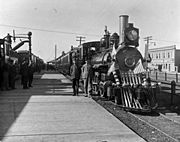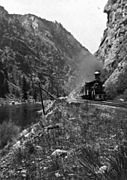Rio Grande 168 facts for kids
Quick facts for kids Denver and Rio Grande Western No. 168 |
|
 |
|
| D&RG No. 168 at the head of a special train taking William Howard Taft to the opening of the Gunnison Tunnel in 1909 | |
| Power type | Steam |
|---|---|
| Reference | |
| Builder | Baldwin Locomotive Works |
| Serial number | 6670 |
| Build date | 1883 |
| Rebuild date | 2016–October 2019 |
| Configuration | 4-6-0 |
| UIC classification | 2′C n2 |
| Gauge | 3 ft (914 mm) |
| Driver diameter | 46 in (1,168 mm) |
| Length | 53.3 ft (16.2 m) |
| Weight on drivers | 50,643 lb (23.0 t) |
| Locomotive weight | 70,550 lb (32.0 t) |
| Locomotive and tender combined weight | 117,950 lb (54 t) |
| Fuel type | Coal |
| Boiler pressure | 160 psi (1 MPa) |
| Cylinders | Two |
| Cylinder size | 14 in × 20 in (356 mm × 508 mm) |
| Tractive effort | 11,590 lbf (51.55 kN) |
| Retired | 1938 (revenue service) |
| Restored | October 2019 |
| Current owner | The City of Colorado Springs, Colorado Cumbres and Toltec Scenic Railroad (operator) |
| Disposition | Operational, in occasional excursion service, based in Antonito, Colorado |
|
Rio Grande Engine No. 168
|
|
| Location | 9 S. Sierra Madre, Colorado Springs, Colorado |
| Area | less than one acre |
| Built | 1883 |
| Architect | Baldwin Locomotive Works |
| NRHP reference No. | 79000601 |
| Added to NRHP | August 10, 1979 |
Denver and Rio Grande Western No. 168 is a class "T-12" 4-6-0 “Ten Wheeler” type narrow-gauge steam railway locomotive. It is one of twelve similar locomotives built for the Denver and Rio Grande Railroad (D&RG) by the Baldwin Locomotive Works in 1883. It was built as a passenger locomotive, with 46 in (1,200 mm) drivers, the largest drivers used on any three foot gauge D&RGW locomotive. The large drivers made it suitable for relatively fast passenger service.
As is the case with many small, early locomotives, we know little of their operating history. In the case of 168, what we know comes entirely from photographs taken of it. The first shows it in the Black Canyon of the Gunnison River in 1904. The second pair show it in Montrose, Colorado, west of Gunnison, at the head of a special train taking President William Howard Taft to the opening of the Gunnison Tunnel which, at the time, was the longest irrigation tunnel in the world. There are also photographs, taken by Otto Perry, showing it in Alamosa in 1923 and Salida in 1929. It was retired in 1938 after a service life of 55 years, later than most of its class.
The railroad gave it to the City of Colorado Springs on August 1, 1938. It was added to the National Register of Historic Places as Rio Grande Engine No. 168 in 1979. Although it sat in Antlers Park, unprotected from the elements, behind a low fence, for so many years, it appeared to be in immaculate cosmetic condition when removed for restoration to operating condition in early 2016.
The city has entered into an agreement with the Cumbres and Toltec Scenic Railroad (C&TSRR) to have the engine restored to working order. The locomotive is now located in Antonito, Colorado.
Restoration was completed in October 2019. The restoration project was headed up by Cumbres and Toltec Special Projects department and lead by Assistant General Manager Efstathios Papas. The project cost $508,000 and took 27 months to complete. The railroad intends to use this engine frequently and put it into normal service as much as possible.
-
In the Black Canyon of the Gunnison, 1904
Images for kids







